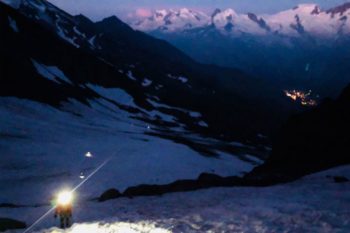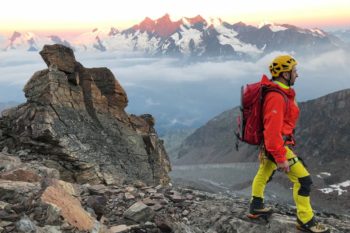On 26 August 1856, Edward Levi Ames climbed the Lagginhorn accompanied by local mountain guides. Already at the first ascent, Ames and his companions chose today’s normal route over the west-southwest ridge. This ridge offers climbing difficulties up to II. Today the Lagginhorn glacier is usually traversed prior to starting the scramble. Although it still exists, it is considered to have few crevasses and relatively “safe”.

Take care, even if the objective dangers are low
Even when a glacier only has one or two crevasses – there is still no reason not to play it safe. In fact, even with a good track choice, you will have to pass some smaller crevasses. These can’t be described as bottomless, but even these crevasses can cause serious injuries if you fall in. Furthermore, the last part of the glacier before you reach the ridge is at risk of rockfall (especially during the descent at midday) and this bottleneck should, therefore, be passed quickly.
Since its first ascent, the Lagginhorn has been climbed several times, but unfortunately, since then, there have been quite a few accidents, some of them fatal.
The approach to the hut
To reach the usual base of a Lagginhorn ascent, namely the Weissmieshütte (2726m), there are basically two variants: Either you use the Hohsaas cable car, which catapults you from Saas Grund to the so-called Kreuzboden (2,400 m) in a very short time (from here it takes you only about an hour to reach the Weissmieshütte), or you choose the ascent under your own steam, which takes you over the picturesque Triftalp.

Invariant 2 you can admire some very authentic old huts with stone roofing in addition to great views of the Mischabel group opposite. The first view of the actual finish – the Lagginhorn – is also extremely spectacular, because from this side the WSW ridge looks much more daunting and steeper than a rating in the II alpine grade would suggest. But don’t worry: Once you are on the ridge, the mountain offers you superb rock and fun scrambling!

We decided for the slower (about 3 hours), but as we find also a nicer approach on foot. By the way, the approach begins directly behind the valley station of the cable car and is well signposted throughout. After leaving Triftalp behind us, we finally reach the intermediate station of the cable car, Kreuzboden, after about two hours. From here the hut is already in sight. It is picturesquely situated in front of the mighty south face of the Lagginhorn. After another hour at a leisurely pace, we set foot upon the panorama terrace of the Weismieshütte and enjoy the highly recommended Rösti and a cool apple tizer.
The normal route – not to be underestimated
Still in the dark, we start the next morning at the Weissmieshütte and follow the path towards the Lagginhorn. As soon as it touches the glacial stream that flows down from the Lagginhorn glacier, we cross it and follow its bank until the terrain becomes steeper (the track itself goes up to the right towards the Hohsaas mountain station).
Now we climb a ridge that rises to the right towards Lagginhorn. Here you will find obvious crampon marks and kerns. Following the ascent traces, one reaches the right edge of Lagginhorn glacier.
After putting on our crampons and taking the precaution to rope up, we cross the glacier in a slightly ascending line at its upper-left edge.
Here, we are heading straight towards the WSW ridge. After a glacier ascent of barely 20 minutes, we enter the rocky block ridge at the clearly recognizable, flattest spot. While we stow rope and glacier equipment back in our backpacks, we admire the sunrise and the alpenglow of the Mischabel group.
After we have left the glacier behind us, the ascent over the rocky WSW ridge begins, which requires occasional climbing. Especially in the upper part of the ridge, there is sometimes a danger of falling rocks or ice due to preceding roped parties – extreme caution is required here, as the ridge is often covered by loose scree. Depending on the conditions (as with any high alpine tour) the level of difficulty of the tour can vary considerably. Especially in the upper and steeper part of the mountain, icing and Verglas can quickly lead to higher difficulties, so crampons and ice axes are definitely necessary if you are unfamiliar with such conditions.
Compared to other four-thousand-meter peaks
Objectively seen, the mountain is not very hard compared to many other Alpine 4000m peaks – but this does not mean that the mountain can be climbed completely without any objective danger and is suitable for every competent hiker. The appropriate mountaineering know-how should be there in the first place in order to reach the summit safely and get back down again.

Side note:
By the way, there is also the possibility to reach the WSW ridge from the Weissmieshütte without glacier contact – but this possibility is rarely used. If you want to use the direct access to the ridge, you should ask the host of the hut about the somewhat hidden entrance to the ridge and, if necessary, explore it the day before the summit.
Tour dates
- Ascent time (Saas Grund – Weissmieshütte): approx. 3h (via Triftalp/Kreuzboden)
- Ascent time (Weissmieshütte-Lagginhorn): approx. 4h (via Laggingletscher/WSW ridge)
- Descent time (Lagginhorn-Weissmieshütte): approx. 3h (via Laggingletscher/WSW ridge)
- Costs mountain railway (Saas Grund – Kreuzboden): Ascent 27€/ ascent and descent 33€
- Alternative for the descent: Monster-Trotti ride over 11km (from Kreuzboden to Saas Grund)
- Elevation gain (Saas Grund-Lagginhorn): 2410 Hm
- Elevation gain (Weissmieshütte-Lagginhorn): 1280 Hm

